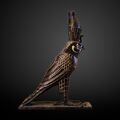سخنت
| Pschent | |
|---|---|
 Pschent, the double crown of Egypt | |
| التفاصيل | |
| البلد | Ancient Egypt |
| السوابق | Deshret Hedjet |
The pschent ( /ˈskɛnt/; Greek ψχέντ) was the double crown worn by rulers in ancient Egypt. The ancient Egyptians generally referred to it as sekhemty (sḫm.ty), the Two Powerful Ones.[1] It combined the White Hedjet Crown of Upper Egypt and the Red Deshret Crown of Lower Egypt.
The Pschent represented the pharaoh's power over all of unified Egypt.[2] It bore two animal emblems: an Egyptian cobra, known as the uraeus, ready to strike, which symbolized the Lower Egyptian goddess Wadjet; and a vulture representing the Upper Egyptian tutelary goddess Nekhbet. These were fastened to the front of the Pschent and referred to as the Two Ladies.
History
| |||||
| Pschent "Double Crown" بالهيروغليفية |
|---|
The invention of the Pschent is generally attributed to the First Dynasty pharaoh Menes, but the first one known to wear a Double Crown was the First Dynasty pharaoh Djet: a rock inscription shows his Horus wearing it.[3]
The king list on the Palermo Stone, which begins with the names of Lower Egyptian pharaohs (nowadays thought to have been mythological demigods), shown wearing the Red Crown, marks the unification of the country by giving the Pschent to all First Dynasty and later pharaohs.[4] The Cairo fragment, on the other hand, shows these prehistoric rulers wearing the Pschent.[5]
Archaeology
As is the case with the Deshret and the Hedjet Crowns, no Pschent is currently known to have survived. It is known only from statuary, depictions, inscriptions, and ancient tales.
Mythology
Among the deities sometimes depicted wearing the Double Crown are Horus[6] and Atum or Ra both representing the pharaoh or having a special relationship to the pharaoh.[7]
Gallery
Fragment of an ivory label showing pharaoh Den wearing the double crown of Upper and Lower Egypt. Discovered in the tomb of Den at Umm El Qa'ab, now in the Egyptian Museum
Ring of Ptolemy VI Philometor wearing the Pschent Double Crown, 3rd to 2nd Century BC. Ptolemaic rulers wore the Pschent in Egypt only and wore the Greek diadem in the other territories
Statue head Senusret III wearing a pschent
Statue of Amenhotep III wearing a pschent
See also
- Atef – Hedjet Crown with feathers identified with Osiris
- Khepresh – Blue or War Crown also called Royal Crown
- N-red crown (n hieroglyph)
- N-water ripple (n hieroglyph)
- Uraeus – Rearing Cobra
References
- ^ Griffith, Francis Llewellyn, A Collection of Hieroglyphs: A Contribution to the History of Egyptian Writing, the Egypt Exploration Fund 1898, p.56
- ^ Dunand, Françoise; Christiane Zivie-Coche, Gods and Men in Egypt: 3000 BCE to 395 CE, Cornell University Press 2004, pp.32f.
- ^ Wilkinson, Toby A. H., Early Dynastic Egypt, Routledge 1999, p.196
- ^ Trigger, B. G. (1982). "The rise of civilization in Egypt". In Clark, J. Desmond (ed.). The Cambridge History of Africa. Volume 1, From the Earliest Times to c.500 BC. Cambridge: Cambridge University Press. p. 521. doi:10.1017/CHOL9780521222150.008. ISBN 9781139054553.
- ^ Kemp, Barry John, Ancient Egypt: Anatomy Of A Civilization, Routledge 2006, p.92
- ^ Zandee, Jan, Studies in Egyptian Religion: Dedicated to Professor Jan Zandee, Brill 1982, p.74
- ^ The New Encyclopædia Britannica, Encyclopædia Britannica, Inc. 2005, p. 689
External links
 Media related to Pschent at Wikimedia Commons
Media related to Pschent at Wikimedia Commons The Wiktionary definition of سخنت
The Wiktionary definition of سخنت





